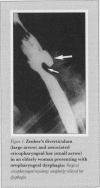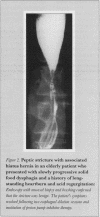Abstract
OBJECTIVE: To review the problem of dysphagia in the elderly so that primary care physicians are better able to recognize and manage it. QUALITY OF EVIDENCE: Dysphagia, a prevalent problem in the elderly, causes significant morbidity and even mortality. Age-related deterioration of the oropharyngeal phase of swallowing is well documented. Diagnosis and treatment of dysphagia in the elderly is based mainly on clinical experience with large groups of patients. Few controlled clinical trials have been conducted. MAIN FINDINGS: Oropharyngeal dysphagia in the elderly is often due to irreversible neuromuscular disease. These patients benefit from swallowing therapy performed by speech pathologists. Esophageal causes of dysphagia are similar in the elderly and young patients, and the approach to treatment is also similar, although noninvasive forms of therapy play a larger role for elderly patients. CONCLUSIONS: Dysphagia is a common problem that lowers quality of life for the elderly. Primary care physicians must be aware of causes of dysphagia for which specific treatments are available, as well as of the role of nonspecific treatments offered by ancillary health professionals.
Full text
PDF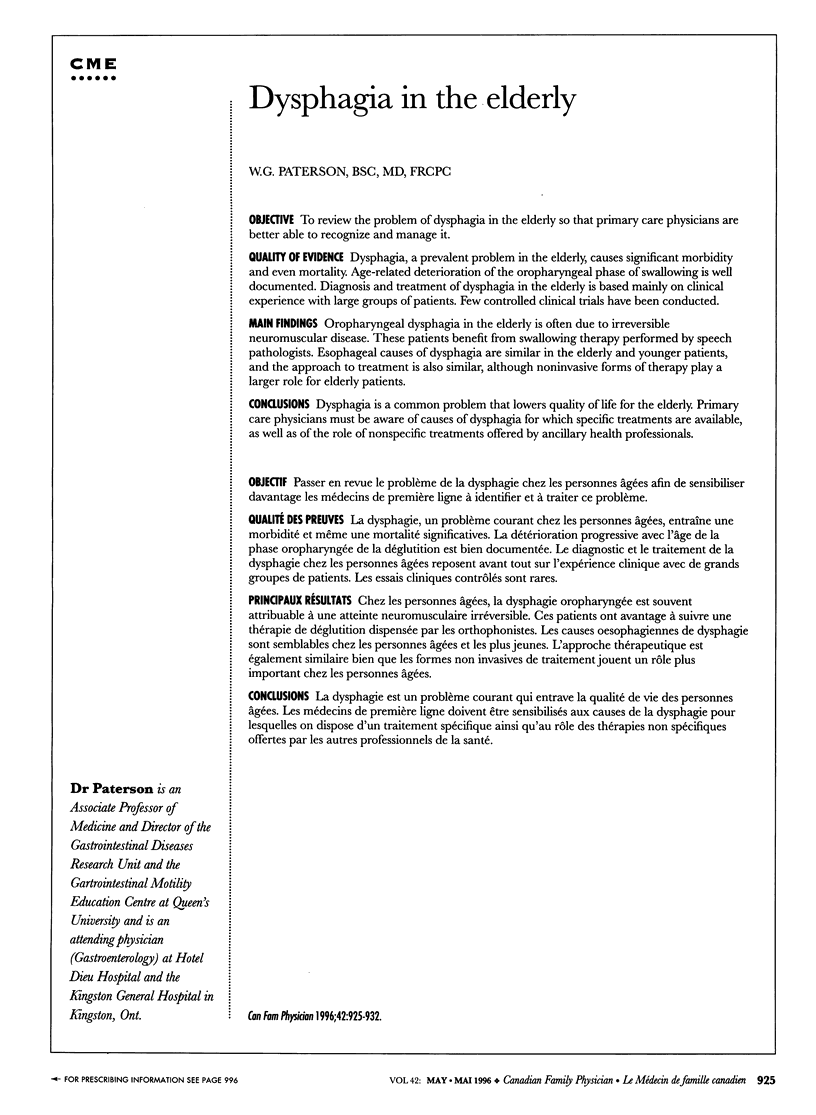
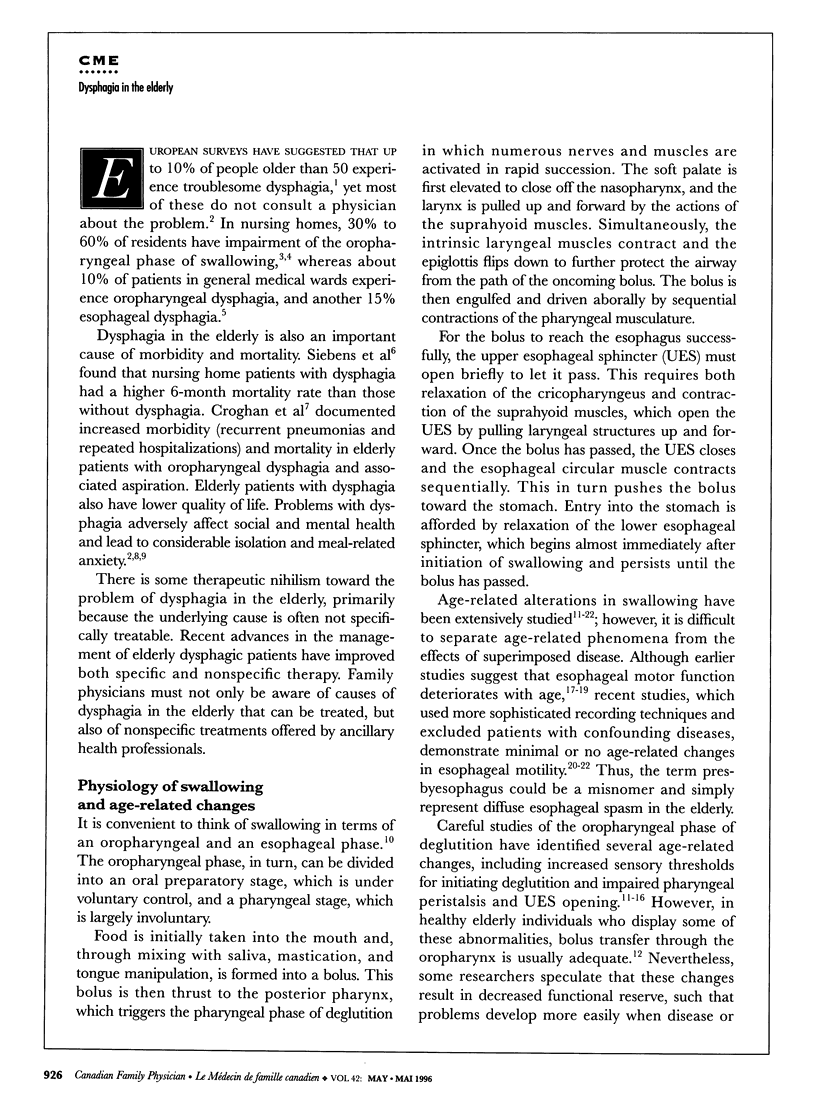
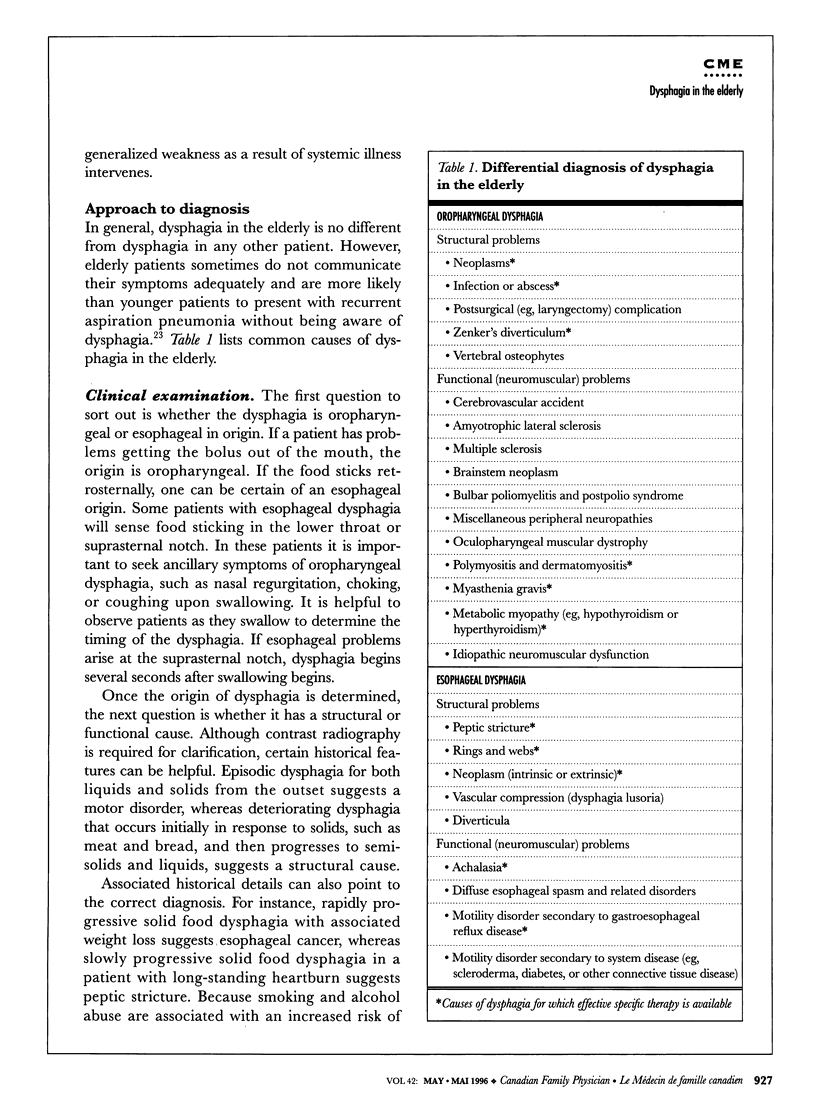
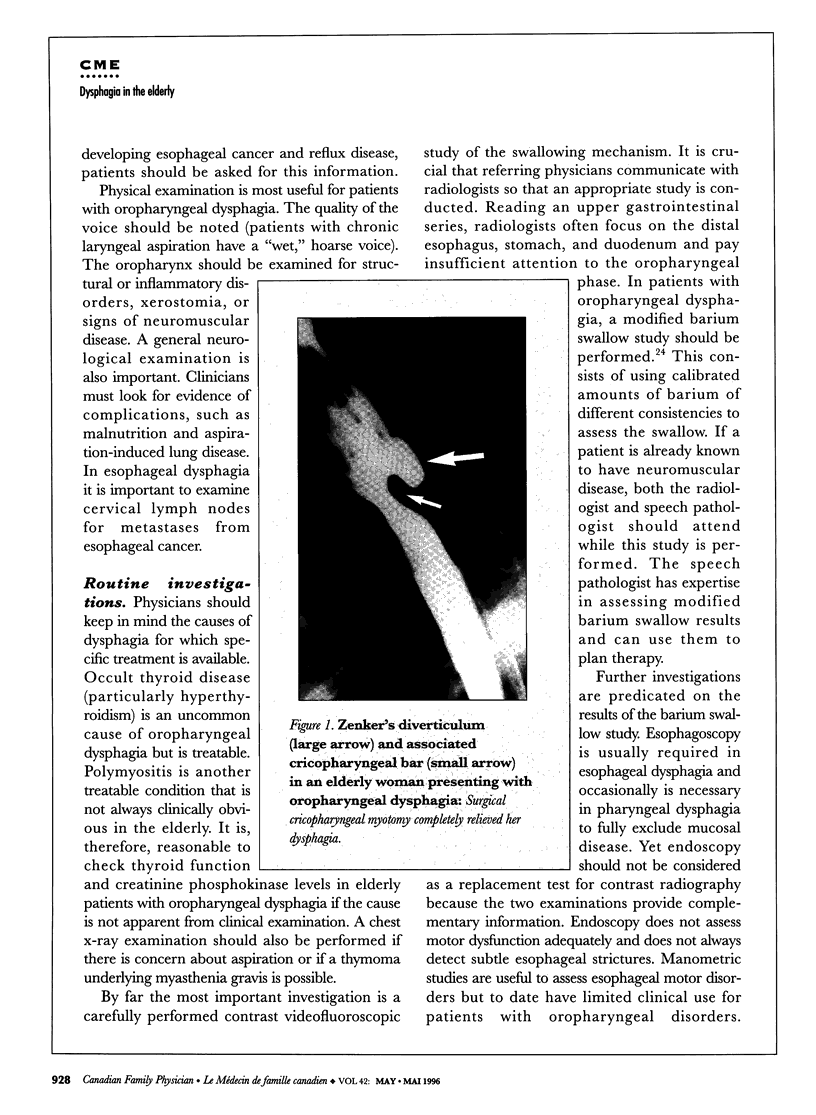
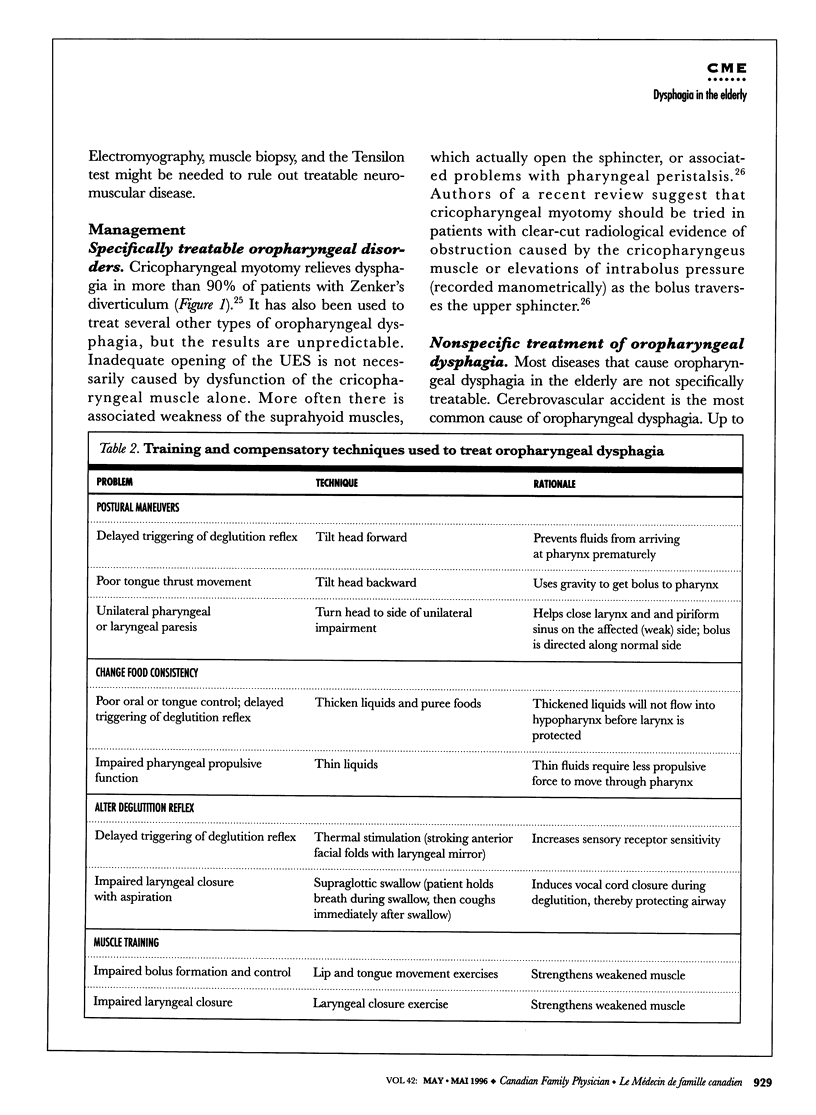
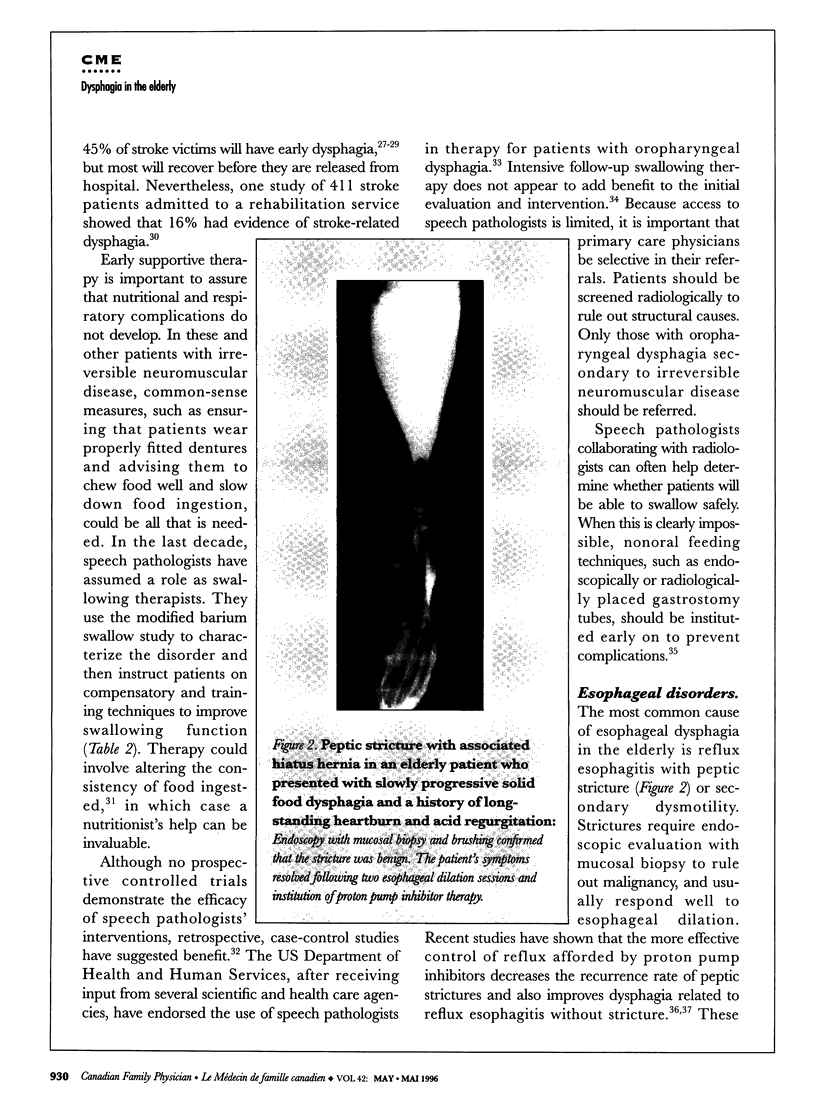
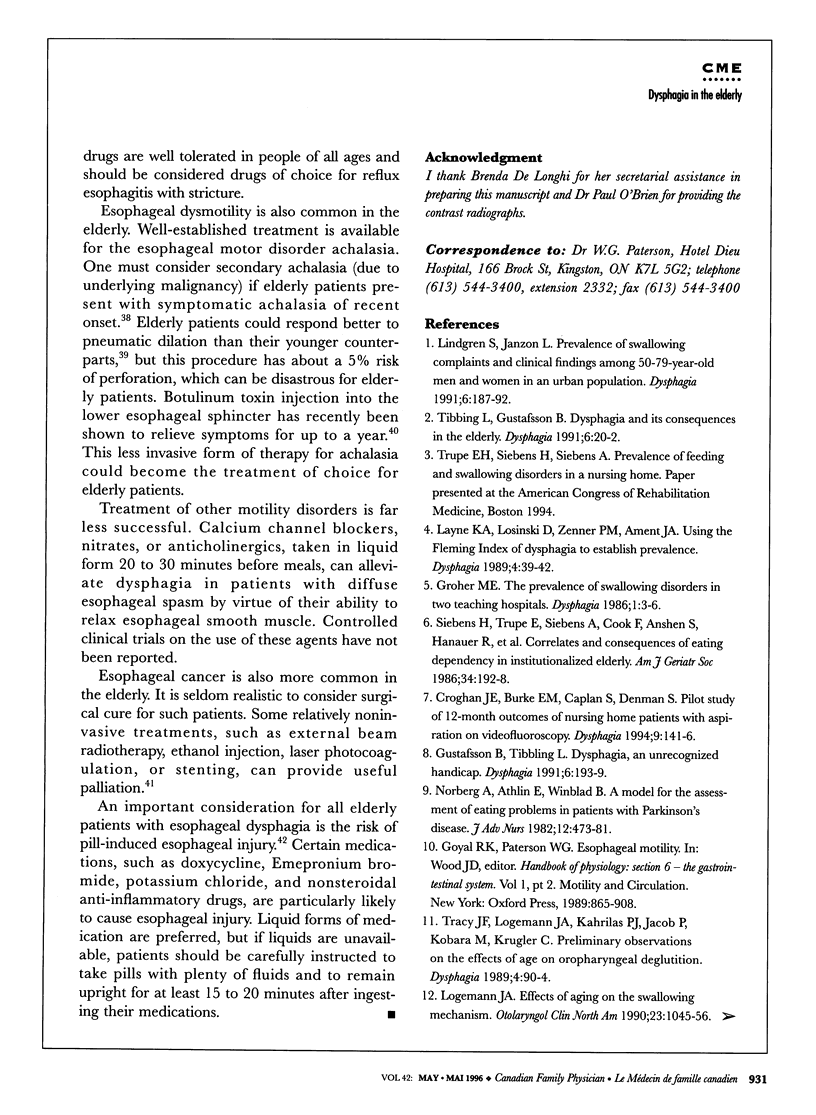
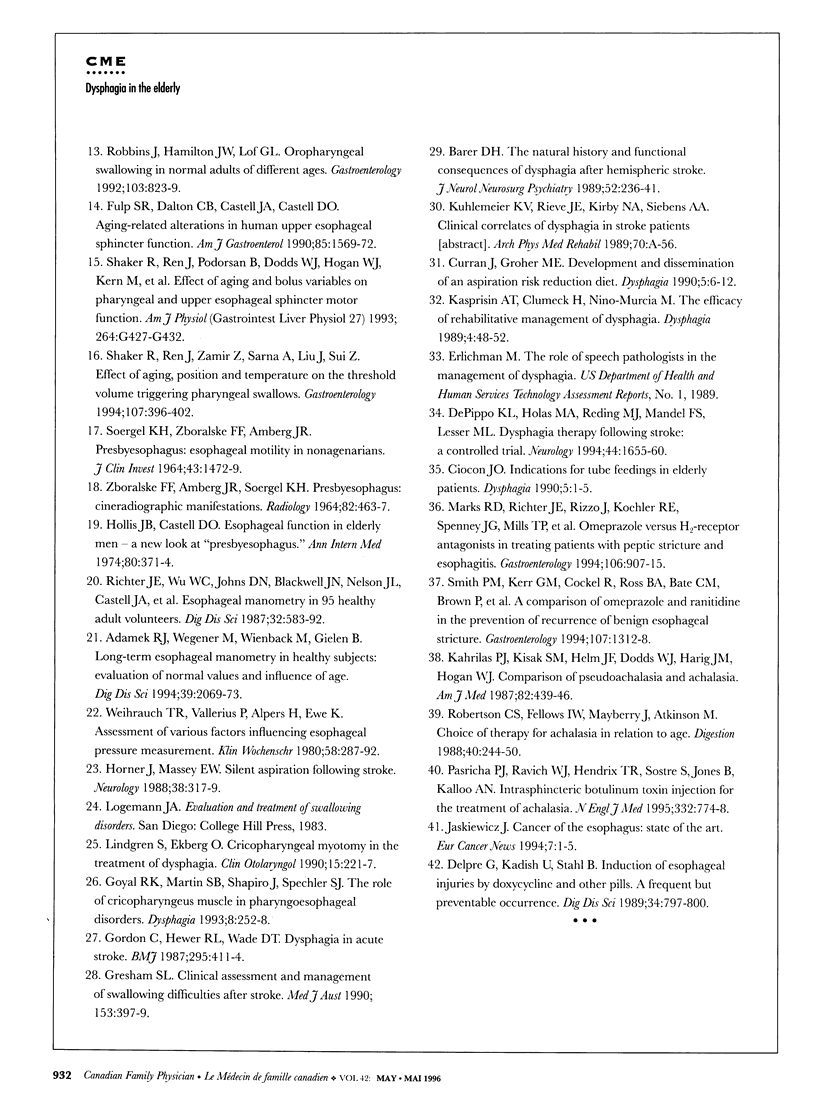
Images in this article
Selected References
These references are in PubMed. This may not be the complete list of references from this article.
- Adamek R. J., Wegener M., Wienbeck M., Gielen B. Long-term esophageal manometry in healthy subjects. Evaluation of normal values and influence of age. Dig Dis Sci. 1994 Oct;39(10):2069–2073. doi: 10.1007/BF02090352. [DOI] [PubMed] [Google Scholar]
- Barer D. H. The natural history and functional consequences of dysphagia after hemispheric stroke. J Neurol Neurosurg Psychiatry. 1989 Feb;52(2):236–241. doi: 10.1136/jnnp.52.2.236. [DOI] [PMC free article] [PubMed] [Google Scholar]
- Ciocon J. O. Indications for tube feedings in elderly patients. Dysphagia. 1990;5(1):1–5. doi: 10.1007/BF02407387. [DOI] [PubMed] [Google Scholar]
- Croghan J. E., Burke E. M., Caplan S., Denman S. Pilot study of 12-month outcomes of nursing home patients with aspiration on videofluoroscopy. Dysphagia. 1994 Summer;9(3):141–146. doi: 10.1007/BF00341256. [DOI] [PubMed] [Google Scholar]
- Curran J., Groher M. E. Development and dissemination of an aspiration risk reduction diet. Dysphagia. 1990;5(1):6–12. doi: 10.1007/BF02407388. [DOI] [PubMed] [Google Scholar]
- DePippo K. L., Holas M. A., Reding M. J., Mandel F. S., Lesser M. L. Dysphagia therapy following stroke: a controlled trial. Neurology. 1994 Sep;44(9):1655–1660. doi: 10.1212/wnl.44.9.1655. [DOI] [PubMed] [Google Scholar]
- Delpre G., Kadish U., Stahl B. Induction of esophageal injuries by doxycycline and other pills. A frequent but preventable occurrence. Dig Dis Sci. 1989 May;34(5):797–800. doi: 10.1007/BF01540356. [DOI] [PubMed] [Google Scholar]
- Fulp S. R., Dalton C. B., Castell J. A., Castell D. O. Aging-related alterations in human upper esophageal sphincter function. Am J Gastroenterol. 1990 Dec;85(12):1569–1572. [PubMed] [Google Scholar]
- Gordon C., Hewer R. L., Wade D. T. Dysphagia in acute stroke. Br Med J (Clin Res Ed) 1987 Aug 15;295(6595):411–414. doi: 10.1136/bmj.295.6595.411. [DOI] [PMC free article] [PubMed] [Google Scholar]
- Goyal R. K., Martin S. B., Shapiro J., Spechler S. J. The role of cricopharyngeus muscle in pharyngoesophageal disorders. Dysphagia. 1993;8(3):252–258. doi: 10.1007/BF01354547. [DOI] [PubMed] [Google Scholar]
- Gresham S. L. Clinical assessment and management of swallowing difficulties after stroke. Med J Aust. 1990 Oct 1;153(7):397–399. doi: 10.5694/j.1326-5377.1990.tb125497.x. [DOI] [PubMed] [Google Scholar]
- Gustafsson B., Tibbling L. Dysphagia, an unrecognized handicap. Dysphagia. 1991;6(4):193–199. doi: 10.1007/BF02493525. [DOI] [PubMed] [Google Scholar]
- Hollis J. B., Castell D. O. Esophageal function in elderly man. A new look at "presbyesophagus". Ann Intern Med. 1974 Mar;80(3):371–374. doi: 10.7326/0003-4819-80-3-371. [DOI] [PubMed] [Google Scholar]
- Horner J., Massey E. W. Silent aspiration following stroke. Neurology. 1988 Feb;38(2):317–319. doi: 10.1212/wnl.38.2.317. [DOI] [PubMed] [Google Scholar]
- Kahrilas P. J., Kishk S. M., Helm J. F., Dodds W. J., Harig J. M., Hogan W. J. Comparison of pseudoachalasia and achalasia. Am J Med. 1987 Mar;82(3):439–446. doi: 10.1016/0002-9343(87)90443-8. [DOI] [PubMed] [Google Scholar]
- Kasprisin A. T., Clumeck H., Nino-Murcia M. Efficacy of rehabilitative management of dysphagia. Dysphagia. 1989;4(1):48–52. doi: 10.1007/BF02407403. [DOI] [PubMed] [Google Scholar]
- Layne K. A., Losinski D. S., Zenner P. M., Ament J. A. Using the Fleming index of dysphagia to establish prevalence. Dysphagia. 1989;4(1):39–42. doi: 10.1007/BF02407401. [DOI] [PubMed] [Google Scholar]
- Lindgren S., Ekberg O. Cricopharyngeal myotomy in the treatment of dysphagia. Clin Otolaryngol Allied Sci. 1990 Jun;15(3):221–227. doi: 10.1111/j.1365-2273.1990.tb00779.x. [DOI] [PubMed] [Google Scholar]
- Lindgren S., Janzon L. Prevalence of swallowing complaints and clinical findings among 50-79-year-old men and women in an urban population. Dysphagia. 1991;6(4):187–192. doi: 10.1007/BF02493524. [DOI] [PubMed] [Google Scholar]
- Logemann J. A. Effects of aging on the swallowing mechanism. Otolaryngol Clin North Am. 1990 Dec;23(6):1045–1056. [PubMed] [Google Scholar]
- Marks R. D., Richter J. E., Rizzo J., Koehler R. E., Spenney J. G., Mills T. P., Champion G. Omeprazole versus H2-receptor antagonists in treating patients with peptic stricture and esophagitis. Gastroenterology. 1994 Apr;106(4):907–915. doi: 10.1016/0016-5085(94)90749-8. [DOI] [PubMed] [Google Scholar]
- Norberg A., Athlin E., Winblad B. A model for the assessment of eating problems in patients with Parkinson's disease. J Adv Nurs. 1987 Jul;12(4):473–481. doi: 10.1111/j.1365-2648.1987.tb01356.x. [DOI] [PubMed] [Google Scholar]
- Pasricha P. J., Ravich W. J., Hendrix T. R., Sostre S., Jones B., Kalloo A. N. Intrasphincteric botulinum toxin for the treatment of achalasia. N Engl J Med. 1995 Mar 23;332(12):774–778. doi: 10.1056/NEJM199503233321203. [DOI] [PubMed] [Google Scholar]
- Richter J. E., Wu W. C., Johns D. N., Blackwell J. N., Nelson J. L., 3rd, Castell J. A., Castell D. O. Esophageal manometry in 95 healthy adult volunteers. Variability of pressures with age and frequency of "abnormal" contractions. Dig Dis Sci. 1987 Jun;32(6):583–592. doi: 10.1007/BF01296157. [DOI] [PubMed] [Google Scholar]
- Robbins J., Hamilton J. W., Lof G. L., Kempster G. B. Oropharyngeal swallowing in normal adults of different ages. Gastroenterology. 1992 Sep;103(3):823–829. doi: 10.1016/0016-5085(92)90013-o. [DOI] [PubMed] [Google Scholar]
- Robertson C. S., Fellows I. W., Mayberry J. F., Atkinson M. Choice of therapy for achalasia in relation to age. Digestion. 1988;40(4):244–250. doi: 10.1159/000199661. [DOI] [PubMed] [Google Scholar]
- SOERGEL K. H., ZBORALSKE F. F., AMBERG J. R. PRESBYESOPHAGUS: ESOPHAGEAL MOTILITY IN NONAGENARIANS. J Clin Invest. 1964 Jul;43:1472–1479. doi: 10.1172/JCI105023. [DOI] [PMC free article] [PubMed] [Google Scholar]
- Shaker R., Ren J., Podvrsan B., Dodds W. J., Hogan W. J., Kern M., Hoffmann R., Hintz J. Effect of aging and bolus variables on pharyngeal and upper esophageal sphincter motor function. Am J Physiol. 1993 Mar;264(3 Pt 1):G427–G432. doi: 10.1152/ajpgi.1993.264.3.G427. [DOI] [PubMed] [Google Scholar]
- Shaker R., Ren J., Zamir Z., Sarna A., Liu J., Sui Z. Effect of aging, position, and temperature on the threshold volume triggering pharyngeal swallows. Gastroenterology. 1994 Aug;107(2):396–402. doi: 10.1016/0016-5085(94)90164-3. [DOI] [PubMed] [Google Scholar]
- Siebens H., Trupe E., Siebens A., Cook F., Anshen S., Hanauer R., Oster G. Correlates and consequences of eating dependency in institutionalized elderly. J Am Geriatr Soc. 1986 Mar;34(3):192–198. doi: 10.1111/j.1532-5415.1986.tb04202.x. [DOI] [PubMed] [Google Scholar]
- Smith P. M., Kerr G. D., Cockel R., Ross B. A., Bate C. M., Brown P., Dronfield M. W., Green J. R., Hislop W. S., Theodossi A. A comparison of omeprazole and ranitidine in the prevention of recurrence of benign esophageal stricture. Restore Investigator Group. Gastroenterology. 1994 Nov;107(5):1312–1318. doi: 10.1016/0016-5085(94)90532-0. [DOI] [PubMed] [Google Scholar]
- Tracy J. F., Logemann J. A., Kahrilas P. J., Jacob P., Kobara M., Krugler C. Preliminary observations on the effects of age on oropharyngeal deglutition. Dysphagia. 1989;4(2):90–94. doi: 10.1007/BF02407151. [DOI] [PubMed] [Google Scholar]
- Weihrauch T. R., Vallerius P., Alpers H., Ewe K. Assessment of various factors influencing esophageal pressure measurement. II. Significance of physiological factors in intraluminal manometry. Klin Wochenschr. 1980 Mar 17;58(6):287–292. doi: 10.1007/BF01476570. [DOI] [PubMed] [Google Scholar]
- ZBORALSKE F. F., AMBERG J. R., SOERGEL K. H. PRESBYESOPHAGUS: CINERADIOGRAPHIC MANIFESTATIONS. Radiology. 1964 Mar;82:463–467. doi: 10.1148/82.3.463. [DOI] [PubMed] [Google Scholar]



